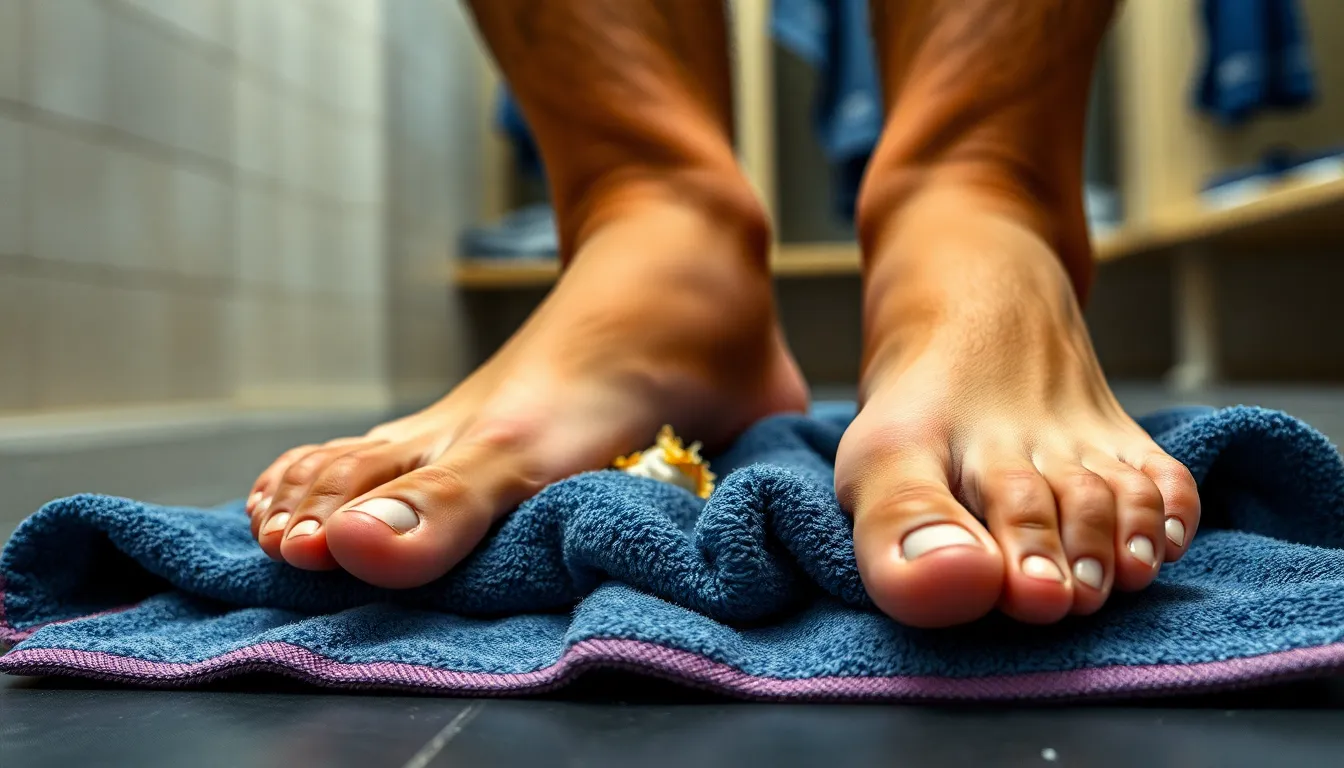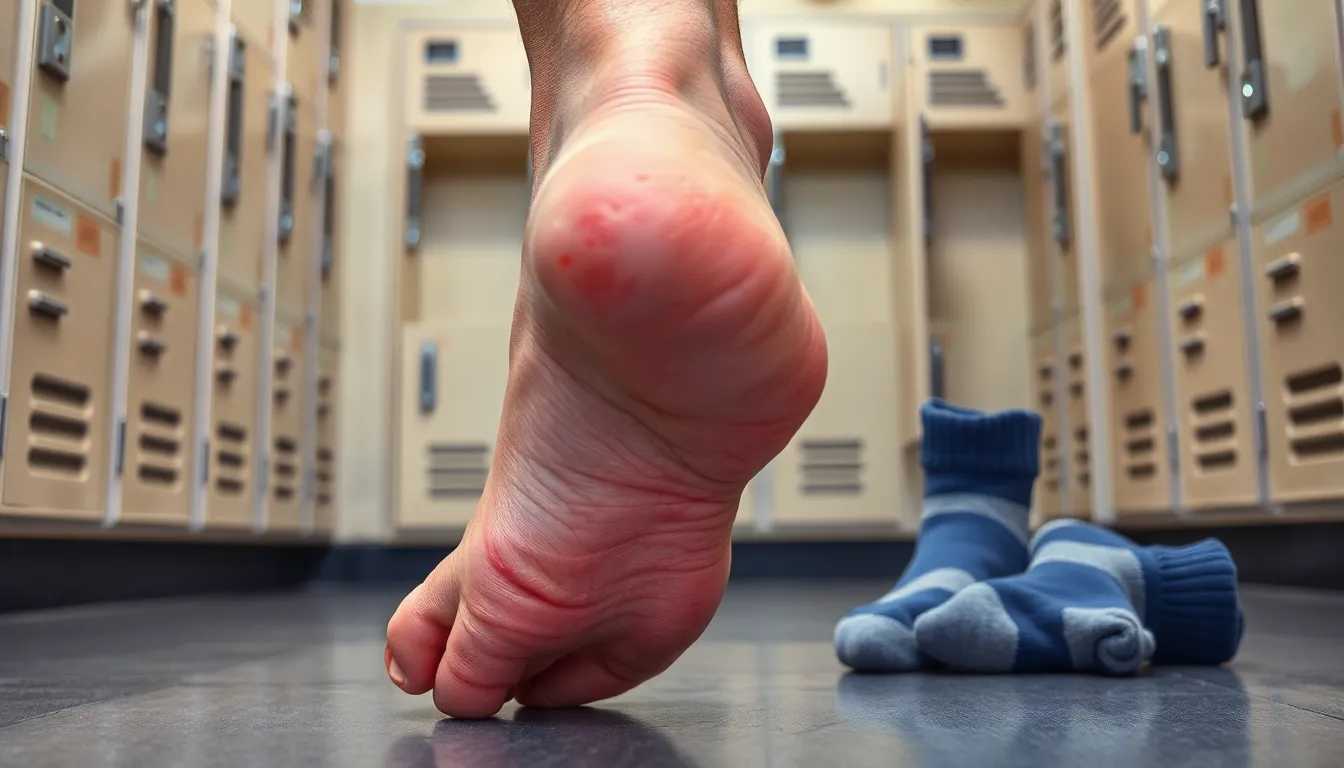Athlete’s foot might sound like a quirky sports injury, but it’s no laughing matter for those dealing with the itchy, burning sensation. This pesky fungal infection loves to hang out in warm, damp places—think gym locker rooms and sweaty socks. If you’ve ever wondered whether this unwelcome guest will ever pack its bags and leave, you’re not alone.
Table of Contents
ToggleUnderstanding Athlete’s Foot
Athlete’s foot, medically known as tinea pedis, results from a fungal infection. Symptoms include redness, peeling skin, and intense itching. This common condition thrives in warm, damp environments, which makes areas like gym locker rooms and public showers prime hotspots for transmission.
Fungi responsible for this infection attach to the skin and multiply, particularly between the toes and on the soles of the feet. It spreads easily through direct contact with infected surfaces or sharing contaminated items like towels and shoes.
Diagnosis of athlete’s foot typically involves a physical examination. A healthcare provider may also perform skin scrapings for laboratory testing to confirm the fungal species. Treatment focuses on antifungal medications, available over the counter or by prescription.
Prevention strategies play a crucial role in managing athlete’s foot. Keeping feet dry and clean is vital, as moisture fosters fungal growth. Wearing breathable footwear and changing socks frequently helps minimize risks as well.
Individuals experiencing persistent symptoms or recurrent infections should consult a medical professional. Addressing athlete’s foot early leads to effective management and reduces the risk of complications. Recognizing the signs and understanding treatment options ensures a quicker recovery timeframe.
Causes of Athlete’s Foot

Athlete’s foot occurs primarily due to specific fungal infections. Understanding these infections and associated factors helps prevent the condition.
Fungal Infections
The primary culprits of athlete’s foot are dermatophytes, a type of fungus. These fungi thrive in warm, moist environments. Common locations include locker rooms, swimming pools, and shared showers. They often spread through direct contact with infected surfaces or contaminated items. Once the fungus penetrates the skin, symptoms manifest, including itching, burning, and peeling. Treatment typically involves antifungal creams or powders that target these fungi effectively.
Contributing Factors
Several factors contribute to the risk of developing athlete’s foot. Wearing tight, non-breathable footwear creates an ideal environment for fungal growth. Excessive sweating also increases moisture between toes. Sharing personal items, such as towels or shoes, heightens the risk of transmission. Weakened immune systems further increase susceptibility to infections. Individuals with pre-existing skin conditions or a history of fungal infections face a higher likelihood of encountering athlete’s foot as well.
Symptoms of Athlete’s Foot
Athlete’s foot presents several recognizable symptoms. These signals help individuals identify the infection early.
Common Signs
Itching often begins between the toes. Burning sensations follow, making walking uncomfortable. Redness on affected areas indicates inflammation. Peeling or cracking skin can develop, particularly around the toe tips. Blisters might form, leading to further irritation. Foul odors sometimes accompany these symptoms, indicating fungal presence. Scratching the affected area can worsen symptoms and heighten the risk of bacterial infection. Observing these signs prompts timely intervention.
Possible Complications
Infections left untreated can worsen, leading to skin fissures. Fissures might allow bacteria to enter the body, resulting in secondary infections. Nail fungus may also develop, causing discoloration and detachment. Chronic athlete’s foot could result in significant discomfort or pain. Individuals with diabetes or compromised immune systems face higher risks of severe complications. Seeking medical attention prevents these complications from escalating. Monitoring symptoms and addressing them promptly preserves foot health.
Treatment Options
Effective treatment options for athlete’s foot focus on addressing the fungal infection and alleviating symptoms. Both over-the-counter remedies and prescription medications play crucial roles in recovery.
Over-the-Counter Remedies
Comprehensive antifungal creams, powders, and sprays are readily available over the counter. Products containing clotrimazole and miconazole offer effective antifungal actions. Applying these treatments twice daily on clean, dry skin proves beneficial for many. People should continue use for at least two weeks after symptoms resolve to prevent recurrence. Antifungal powders can also help absorb moisture and provide additional comfort.
Prescription Medications
Prescription medications may be necessary for severe cases or persistent infections resistant to over-the-counter treatments. Options include oral antifungals such as terbinafine or itraconazole, which target fungi more effectively. Doctors often recommend these to individuals with weakened immune systems or those suffering from recurring infections. Regular follow-ups ensure treatment effectiveness and monitor any potential side effects. Prompt consultation with a healthcare provider guarantees the best approach for managing symptoms and fostering recovery.
Prevention Tips
Preventing athlete’s foot involves practical strategies focusing on hygiene and footwear choices. Implementing these tips can significantly reduce the risk of infection.
Good Hygiene Practices
Maintaining foot hygiene plays a critical role in prevention. Wash feet daily using soap and water; paying special attention to areas between toes helps eliminate fungi. Drying feet thoroughly after washing is vital to avoid moisture accumulation. Regularly changing socks, ideally daily or after activities, keeps feet dry and fresh. Avoid wearing damp socks or shoes, as moisture creates an ideal environment for fungal growth. Sharing personal items like towels and shoes can lead to infections; therefore, limiting shared use minimizes risk. Frequent foot inspections help detect any unusual symptoms early on.
Proper Footwear Choices
Selecting appropriate footwear is essential for foot health. Breathable shoes made from materials like canvas or leather allow airflow, reducing moisture buildup. Wearing flip-flops or shower shoes in communal areas, like locker rooms and pools, protects feet from fungal exposure. It’s important to choose socks made from moisture-wicking fabrics that draw sweat away from the skin. Opt for shoes that provide a proper fit, avoiding tight or non-breathable footwear that can trap heat and moisture. Allow shoes to dry completely before wearing them again, ensuring they remain free from fungal growth. Regularly rotating footwear helps keep feet comfortable and lowers the risk of infection.
Athlete’s foot can be a frustrating and uncomfortable condition but it’s manageable with the right approach. By adhering to effective treatment options and preventive measures individuals can significantly reduce the risk of recurrence. Staying vigilant about foot hygiene and making informed footwear choices are key steps in maintaining foot health.
For those experiencing persistent symptoms or complications seeking professional medical advice is crucial. Early intervention can lead to quicker recovery and prevent further issues. With proper care and attention athlete’s foot doesn’t have to linger and can be effectively resolved.




